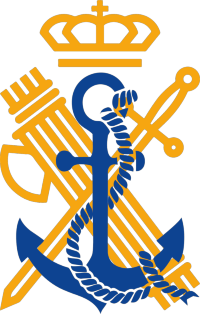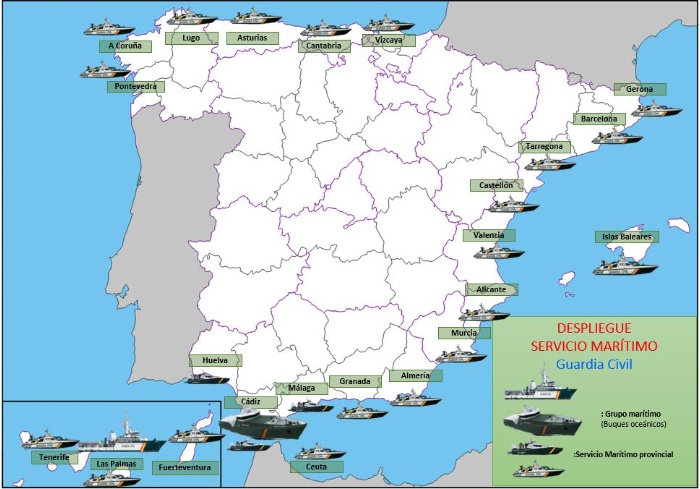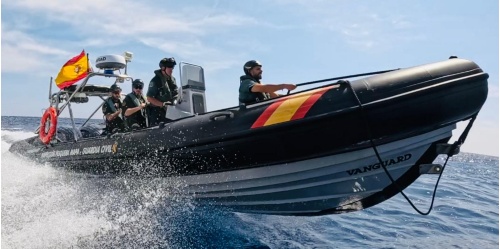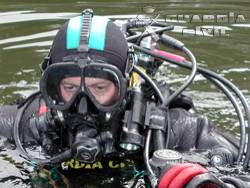Especialidad marítimo y actividades subacuáticas
In this section, you will find information about the specialists of the Guardia Civil who serve in Spanish maritime waters and in continental waters, including activities in the underwater environment, and in particular, the custody of the coasts and the control of irregular immigration. They are specialists from the Marine Services and the Special Groups of Underwater Activities (GEAS). You will learn about their creation and history, their general mission, their structure and organization, and their territorial deployment.
Creation and History
The Organic Law 2/1986, of March 13, 1986, of the Security Forces and Corps in its article eleven. 2.b, says that Guardia Civil will exercise the functions that, with generic character are assigned to the Forces and Corps of Security of the State, among others, in the territorial sea.

Royal Decree 246/1991, of February 22, 1991, wich regulates the Maritime Service of the Guardia Civil, contemplating in its first article:
"The functions that Organic Law 2/1986 of 13/03 on Security Forces and Corps attributes to the Guardia civil Corps will be exercised in Spanish maritime waters up to the outer limit of the territorial sea established by the legislation in force and, exceptionally, outside the territorial sea, in accordance with what is established by international treaties."
This meant extending to the sea demarcation what the Guardia civil had been doing on land.
The first vessels of the Maritime Service were delivered in 1992, which served in the Barcelona Olympics Games and the Seville Universal Exposition.
Subsequently, the service was extended to cover the demarcation are for which it is responsable.
General Mission
According to the provisions of Royal Decree 207/2024, of February 27, which develops the basic organic structure of the Ministry of the Interior, the Maritime Service "is responsible for (...) the custody, control and surveillance of (...) the maritime areas in which Spain exercises sovereignty and, in this area, the control of irregular immigration", developing the Coast Guard functions assigned to the Ministry of the Interior, including activities in the underwater environment.
Fundamental tasks
- Judicial Police: Prevention and investigation of crimes, initial investigations and reports.
- Fiscal Protection: Fiscal protection of the State and actions aimed at preventing and prosecuting smuggling.
- Border Control: Fight against irregular immigration.
- Administrative Police: Conservation of nature and the environment, control and inspection of fishing and sport boats, protection of submerged historical heritage and control of irregular immigration.
- Missions abroad: Participation in those international police cooperation, peacekeeping or humanitarian missions that take place in the maritime field.
- Collaboration and national cooperation: Collaboration relations with other Spanish organizations with competences at sea, such as Maritime Rescue, Merchant Marine, Customs, Environment, Fisheries and the Navy.
Organization and structure
The Coastal and Maritime Police Headquarters, under the Border and Maritime Police Command, is the superior body to which the Maritime Service reports.The Maritime Service is structured as follows:
- Service Headquarters: Central Body located in Madrid, responsible for the technical direction and advice to the Command.
- SEMAR Training and Doctrine Unit: based in Cadiz, it acts as the Civil Guard's Maritime Training Center, providing specialization and refresher courses for the Service's personnel, as well as for Civil Guard personnel who must steer vessels and training foreign personnel within the framework of international cooperation".
- Maritime Groups: Organizational units in which the Oceanic Vessels of the Maritime Service of the Guardia Civil are integrated.
- Provincial Maritime Services: Territorial bodies of the Service that coincide with each province with a coastline. They depend organically and functionally on the territorial Civil Guard Command where they are located and technically on the Maritime Service Headquarters.
- U.A.S. (Underwater Activities Unit): under the Maritime Service Headquarters, which is responsible for carrying out the functions and activities entrusted to the Civil Guard in the aquatic and underwater environment.
- G.E.A.S. (Groups of Specialists in Underwater Activities): Territorial bodies of the underwater specialty, they depend organically and functionally on the Zone or Unit Headquarters where they are located and technically on the Command of the Underwater Activities Unit.
Territorial Deployment
The territorial deployment of the Maritime Service covers the entire Spanish coast, articulating different Units.
-
Maritime Groups: Units in which the Oceanic Vessels of the Guardia Civil are integrated. They are based in Las Palmas de Gran Canaria (Grupo Marítimo de Canarias) and in Cadiz (Grupo Marítimo del Estrecho), and depend organically, functionally and technically on the central body of the Maritime Service.
-
Provincial Maritime Services: Territorial units coinciding with each province with coastline. They depend organically and functionally on the Command where they are located and technically on the central body of the Maritime Service.

Creation and history
The creation of the Underwater Activities Unit dates back to 1981. In 1997, the Unit was integrated into the Maritime Service with the specific task of providing specialized support to the Groups of Specialists in Underwater Activities (GEAS) or units of the Civil Guard that may require it.
General Mission
Exercise the functions that correspond to the Civil Guard related to the aquatic and underwater environment, whether or not they require the use of autonomous means of breathing for their execution.
Fundamental tasks
- Search, location and recovery of people and objects in aquatic and underwater environments.
- Search, location and recovery of people and objects.
- Recognition, security and protection of personalities, installations, vessels, works or objects.
- Surveillance, prevention and protection of submerged cultural, historical and natural heritage.
- Performing reconnaissance and safety tasks in competitions or recreational activities in the aquatic or underwater environment.
- Performance of Judicial Police functions in their specific environment.
- Support to other Units of the Corps in the technical and operational aspects related to the activities of the Specialty or the specific means used for the development of the same.
- Search and location of explosive devices.
- Practice of underwater demolitions in certain circumstances.
- Recognition and exploration of seabed or underwater with remote means.
- To ensure compliance with the regulations and provisions in force related to underwater activities.
- Collaboration with similar teams, military or civilian.
Organization and structure
The Underwater Activities Unit performs its functions according to the following organizational structure:
Organización Central
The Underwater Activities Unit (UAS), based in Valdemoro (Madrid), is the central body of the Maritime Service of the Civil Guard for the fulfillment of the mission and tasks entrusted to the Underwater Activities Units. The UAS is made up of:
- Command
- Plana Mayor
- Central Group of Underwater Activities (GRUCEAS). Operational unit of the Central Body that provides its own services in its specific demarcation, while constituting a reserve of the Command to project specialized human and material resources nationwide.
- Technical Group of Underwater Activities (GRUTAS), whose mission is to be ready to undertake the services entrusted to the Civil Guard in underwater environments at absolute pressures higher than 6 atmospheres of pressure and in places where dives must be performed in confined spaces.
Peripheral Organization
Groups of Specialists in Underwater Activities (GEAS), are the decentralized bodies for the fulfillment of the mission and tasks entrusted to the Underwater Activities Units in the Zones or Units in which they are organically framed. They technically depend on the Underwater Activities Unit Command.
Territorial Deployment
The Groups are currently deployed in the following provinces:
Alicante, Almería, Asturias (Gijón), Barcelona, Badajoz, Cádiz (Algeciras), Cuenca, Gerona (L'Estartit), Huesca, Balearic Islands (offices in Palma de Mallorca and Ibiza), La Coruña, La Rioja, Las Palmas, Málaga, Murcia (Cartagena), Santa Cruz de Tenerife, Seville, Valencia, Valladolid and the Autonomous Cities of Ceuta and Melilla.
Background
In line with the organizational needs of the Coastal and Maritime Police Headquarters, at the proposal of the Lieutenant General, Operational Deputy Director, and in accordance with the provisions of Article 4.1.a) of Royal Decree 734/2020, of August 4, which develops the basic organic structure of the Ministry of the Interior, by resolution (BOGC nº: 24 of June 13, 2023), the Training and Doctrine Unit of the Maritime Service in Cadiz is created.
Dependency
The UFyD is organically, technically and functionally dependent on the Maritime Service (Central Body) and its technical-educational coordination is carried out by the Centro de Perfeccionamiento de la Guardia Civil, under the direction of the Jefatura de Enseñanza.
Values
The Training and Doctrine Unit of the Maritime Service of the Civil Guard instills in its students values intrinsic to the seafaring profession such as comradeship, the capacity for sacrifice, loyalty, respect and care for the sea and the duty to help. All of this is done by upholding honor as the main value of the Corps and common to all Civil Guards.
Vision
To manage, through the Training Center, the technical-educational activities within the maritime field entrusted to it by the Civil Guard Teaching Headquarters and the Coastal and Maritime Police Headquarters, aimed at achieving a framework of excellence, visible in the fulfillment of our missions as maritime police.
Functions
The mission of the Training and Doctrine Unit of the Maritime Service of the Civil Guard is to specialize in the exercise of activities in specific areas of professional action, and to expand or update the knowledge and skills required for the exercise of the Maritime specialty.
In particular, it is the responsibility of the UFyD, through the Development Center:
- Define the training necessary to achieve and maintain the professional competencies and aptitudes required in the Maritime specialty, preparing and, if necessary, teaching the corresponding study plans or training programs.
- Evaluate the teachings and processes that are taught or managed within the Maritime specialty, introducing or proposing the necessary modifications to achieve excellence and quality.
- To promote the development of training activities in the field of Improvement Education.
- To manage the knowledge of the teaching of interest for the Civil Guard, in the field of the Maritime specialty, maintaining its permanent updating.
- Cooperate with other national or foreign educational centers and institutions in training in the field of maritime police functions.
- Manage the formation of the necessary tribunals for the selection of attendees to the courses taught in the Unit, or, if necessary, for the materialization of the same.
- Proposal and execution of courses for access to the different Maritime specialty modalities, and those for updating or expanding knowledge, in order to maintain specific qualifications.
- The organization and management of continuous training activities, in those aspects deemed necessary, to be developed in the different units of SEMAR.
- Periodic updating of the SEMAR Manual.
- Support to the command of the Maritime Service, in the elaboration of the doctrine and procedures of the maritime specialty and in the tasks assigned to it within its scope.
- Any other tasks entrusted by the person in charge of the Directorate General of the Civil Guard.
Environment
Commitment to the protection, conservation and improvement of the environment. The UFyD incorporates in all the curricula of the access courses to the Maritime specialty, the measures to be adopted by all ships and vessels to protect the marine environment and prevent marine pollution.
Instalaciones
The building consists of the following facilities:
- An assembly hall with 106 seats
- Pattern classroom.
- Mechanical classroom.
- Maritime safety classroom.
- Navigation simulator classroom.
- Radio simulator classroom
- Mechanical workshop.
- Electrical and electronics workshop.
- Offices, changing rooms, etc.
- An added value of the SEMAR Training Center is the 25-meter patrol boat Río Pisuerga, which is dry-docked next to the building.
- It also has an offshore vessel (Cabaleiro), a high-speed patrol boat of the Colimbo type (Río Ulla) and several semi-rigid vessels.
Training provided
The courses, seminars and conferences that the SEMAR Training Center usually offers are the following:
- SEMAR's Boat Patron
- SEMAR Mechanic Seaman
- SEMAR Maintenance Mechanic
- Basic Navigation Skipper
- Knowledge Updating Days for all components assigned to SEMAR.
- Boarding Officer.
- Environmental Training on Marine Pollution and Sampling in the Marine Environment.
- Basic Training in Maritime Safety.
- Navigation phase of the GEAS course.
- Swimming, Intervention and Rescue (NIR) in collaboration with UAS.
- A-191 Deep-sea Vessels Qualification Course
- HS60 series patrol boat knowledge days
- Conference on Operational Intervention in the marine environment for the Reserve and Security Group.

